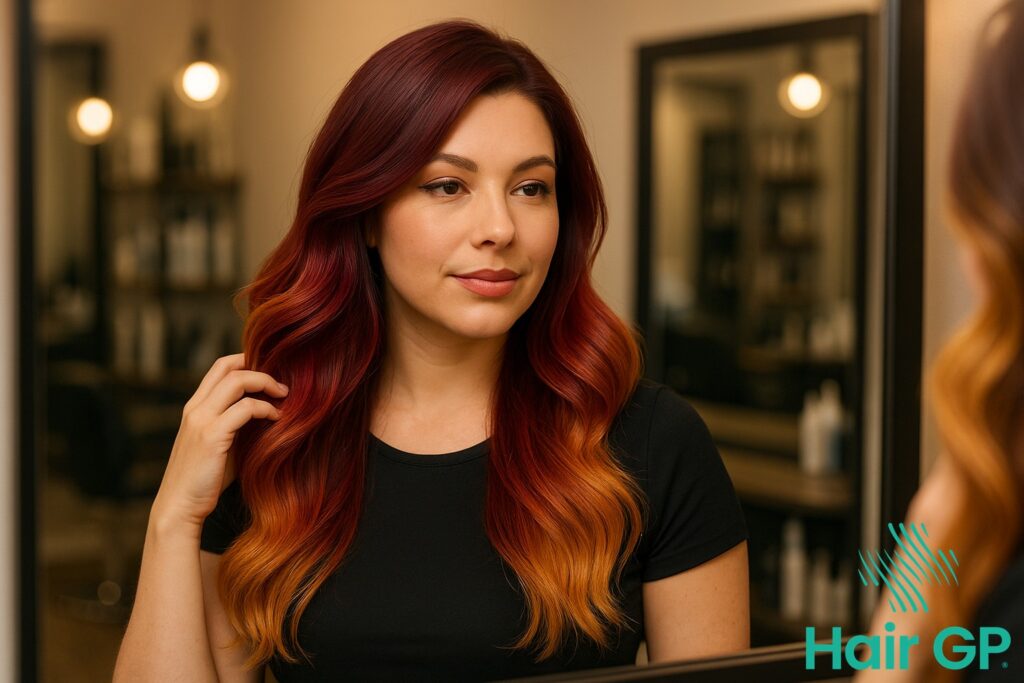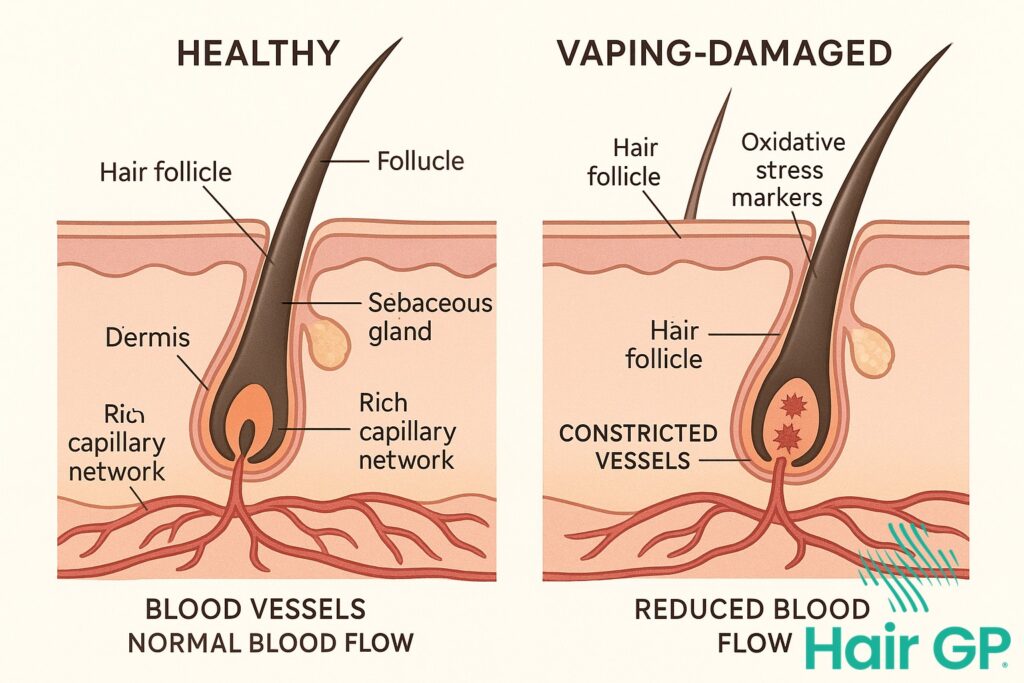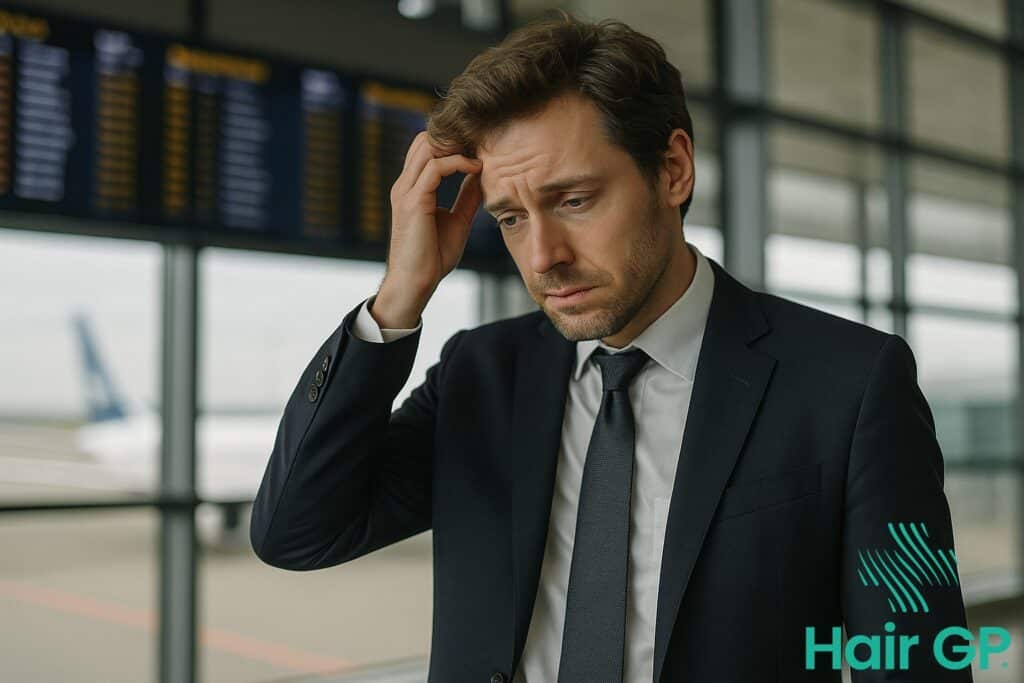Introduction
For millions of people experiencing hair loss, the question of whether to continue colouring their hair can feel overwhelming. The fear that hair dye might worsen thinning hair or interfere with treatment often leads to unnecessary anxiety and drastic decisions. If you’re wondering whether you need to abandon your colour-treated hair routine whilst addressing hair loss concerns, you’re not alone.
The good news is that most people don’t need to completely stop dyeing their hair during hair loss treatment. Understanding the relationship between hair dye and hair damage, however, is crucial for making informed decisions about your hair care routine. This comprehensive guide will help you navigate the complexities of maintaining dyed hair whilst managing thinning hair conditions.
We’ll explore how different types of hair dye affect your hair and scalp, examining everything from permanent colours to gentler alternatives. You’ll learn the important distinction between hair breakage and actual follicular hair loss, helping you identify whether your hair dye is truly contributing to your concerns.
Throughout this article, we’ll provide practical strategies for safely colouring thinning hair, including timing recommendations and application techniques that minimise potential damage. We’ll also explore creative alternatives that allow you to maintain your desired look without compromising your hair health.
Whether you’re dealing with genetic hair loss, medical conditions, or treatment-related thinning, this guide offers evidence-based solutions tailored to your needs. We’ll also help you recognise when professional consultation becomes necessary, ensuring you make the best decisions for your hair’s health and appearance.
Key Takeaways – TL/DR
- Most hair dyes don’t directly cause permanent hair loss but can contribute to hair breakage and temporary shedding
- Semi-permanent dyes are generally safer than permanent hair color for those experiencing hair thinning
- Proper scalp care and choosing gentle formulas can allow you to continue coloring while treating hair loss
- Consulting a hair specialist Doctor is crucial if you experience allergic reactions or severe scalp irritation from dyes
Understanding the Relationship Between Hair Dye and Hair Loss
Understanding how hair dye interacts with your hair is crucial for making informed decisions during hair loss treatment. Hair dye primarily affects the hair shaft – the visible portion of hair above the scalp – rather than the hair follicles beneath the skin’s surface where hair actually grows [1]. The chemical process of colouring alters the structure of the hair shaft by lifting the cuticle and depositing or removing pigment, but this action doesn’t penetrate deep enough to damage the follicle or disrupt the growth phase.
The confusion often arises from mistaking hair breakage for actual hair loss. When hair becomes damaged from excessive chemical processing, it may break off along the shaft, creating the appearance of thinning. However, this differs fundamentally from true hair loss, where follicles stop producing hair or enter prolonged resting phases. Research indicates that whilst hair dye can cause structural damage leading to breakage, it rarely causes permanent follicular damage or interrupts normal hair growth cycles [2].
This distinction means most people experiencing hair loss can continue colouring their hair with appropriate precautions. The key lies in maintaining healthy hair practices and choosing gentler formulations when possible, rather than abandoning colour treatments entirely.
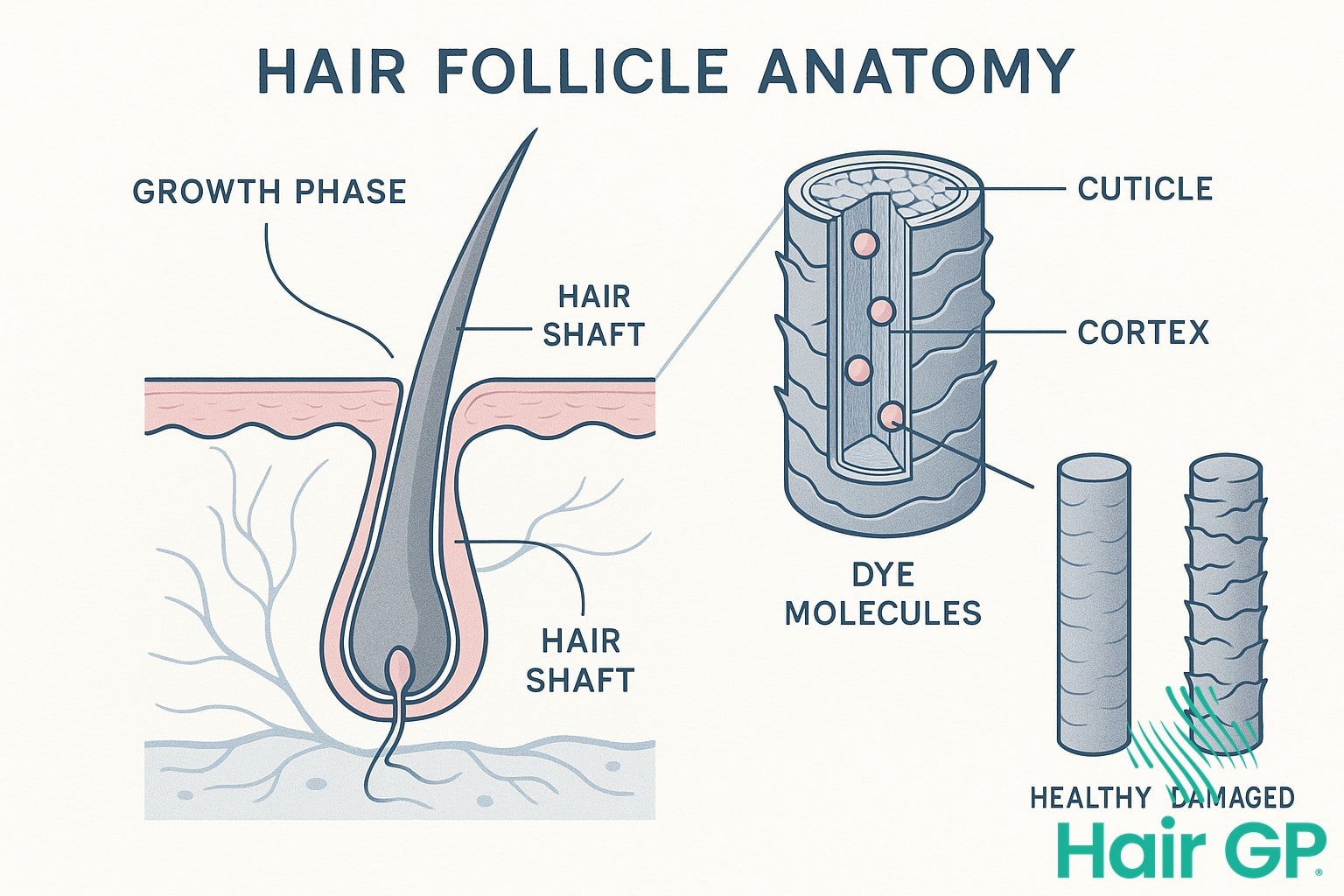
Types of Hair Dye and Their Impact on Thinning Hair
Different hair dye formulations vary significantly in their chemical composition and potential impact on those experiencing hair loss. Understanding how permanent hair color, semi permanent dyes, and natural alternatives affect already compromised hair follicles helps inform safer colouring choices for individuals managing thinning hair conditions.
Permanent vs Semi-Permanent Hair Color
Permanent hair color contains ammonia and hydrogen peroxide, which lift the cuticle and penetrate deeply into the hair shaft [3]. This process can make hair brittle and more prone to breakage, particularly concerning for those with existing hair loss. Semi permanent dyes typically lack ammonia, depositing colour on the hair surface without significant cuticle damage, lasting 6-12 washes versus permanent colour’s indefinite duration.
Natural and Vegetable-Based Alternatives
Vegetable based dyes like henna offer gentler colouring options for sensitive scalps. Henna binds to keratin without requiring chemical developers, potentially strengthening hair whilst providing colour [4]. However, natural dyes have limitations including restricted colour ranges and potential allergic reactions. Some individuals experience scalp irritation from plant compounds, requiring patch testing before application.
Safe Hair Dyeing Practices During Hair Loss Treatment
Colouring your hair whilst managing hair loss requires a careful balance between maintaining your desired appearance and protecting your hair health. By following specific guidelines, you can minimise potential damage to thinning hair whilst continuing your colour routine during treatment.
Pre-Dye Preparation and Testing
Before applying any colour, conduct a patch test 48 hours in advance, especially if experiencing hair shedding or telogen effluvium. Examine your scalp thoroughly for irritation, wounds, or excessive sensitivity. Time your colouring sessions at least two weeks after starting any new hair loss treatments to allow your scalp to adjust. Consider semi-permanent dyes over permanent options to reduce chemical exposure and maintain hair integrity.
Post-Colour Hair Care Routine
After colouring, switch to sulphate-free shampoos that won’t strip colour or damage new hair growth. Apply deep conditioning treatments weekly, focusing on mid-lengths and ends whilst avoiding the scalp. Use heat protection sprays before styling, keeping temperatures low. Extend time between colour applications to 8-10 weeks, allowing your hair to recover. Incorporate protein treatments monthly to strengthen existing strands and support emerging hair during the regrowth phase.
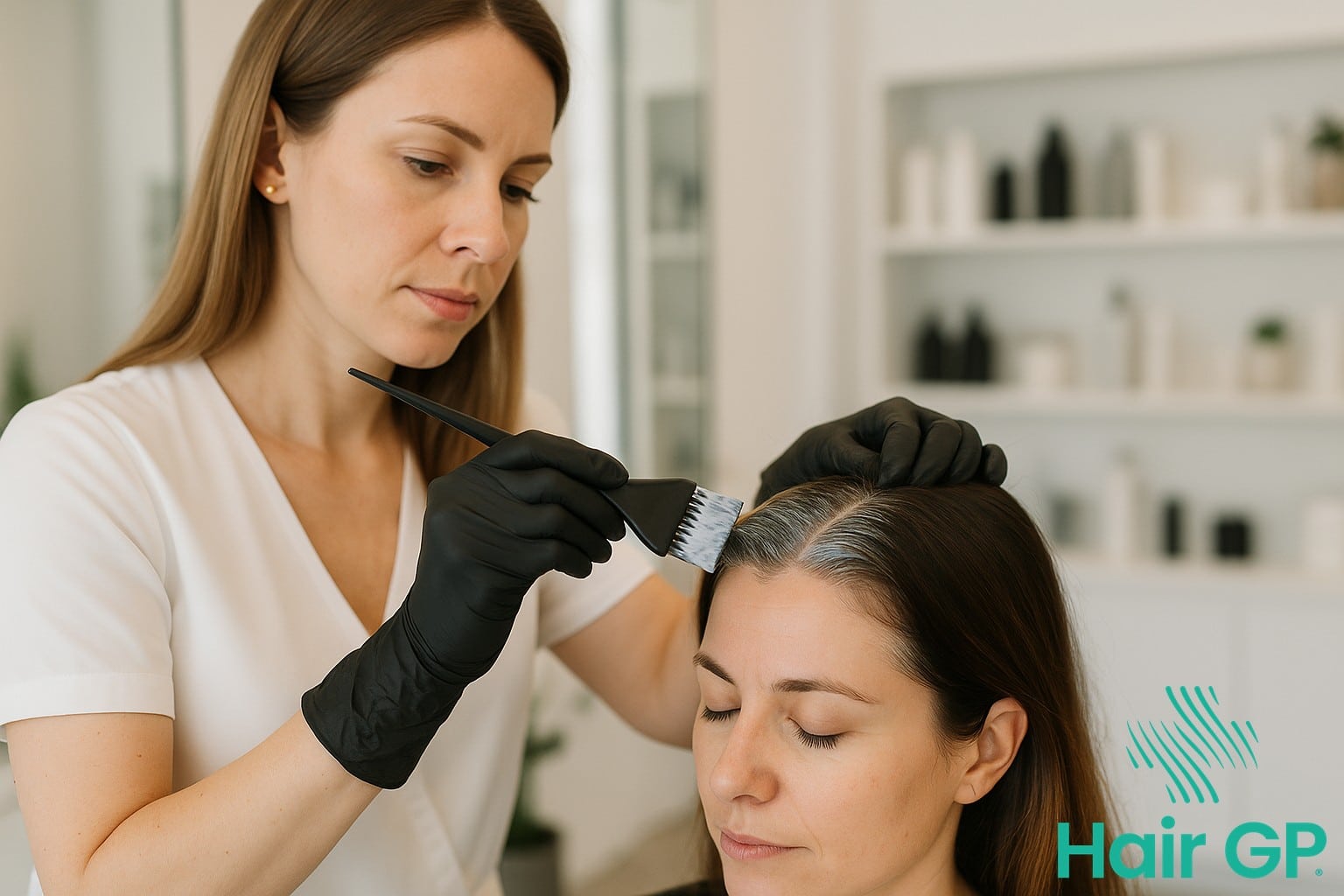
Alternative Solutions for Colour Without Compromise
For those seeking a new hair colour whilst avoiding harsh chemicals, temporary alternatives offer brilliant solutions that won’t compromise scalp health. Spray-on colour powders and chalks provide instant colour change that washes out with a single shampoo, making them ideal for special occasions or testing different shades before committing to a dye job. These products coat the hair shaft rather than penetrating it, preventing damage whilst still delivering vibrant results.
Root touch-up powders and mascaras have revolutionised maintenance between hair salon visits, allowing you to disguise regrowth without exposing your scalp to chemicals. Similarly, semi permanent color rinses containing vegetable-based pigments offer gentle tinting that gradually fades over several washes. For those embracing their natural hair color, colour-depositing conditioners can enhance existing tones whilst nourishing strands.
Styling techniques also provide clever camouflage options. Strategic use of headbands, scarves, and hair accessories can disguise roots whilst adding fashionable flair. Temporary hair extensions or clip-in highlights offer instant transformation without any chemical exposure, perfect for those undergoing active hair loss treatments.
When to Consult a Professional
Seek immediate professional consultation if you’ve experienced hair loss beyond normal shedding, severe allergic reactions, or scalp irritation persisting after dyeing. Conditions like alopecia areata or telogen effluvium require expert diagnosis. A Specialist Hair Doctor can determine whether your hair loss is dye-related or indicates underlying conditions requiring specialised treatment.
Conclusion
Experiencing hair loss doesn’t mean you must abandon your hair colouring routine entirely. With the right approach, you can continue enjoying your preferred hair colour whilst addressing your hair concerns. The key lies in adapting your methods and choosing products that work harmoniously with your specific hair types and scalp condition.
By selecting gentler formulas, implementing safe application techniques, and carefully monitoring your scalp’s response, you can minimise the risk of further damage. Understanding whether you’re dealing with temporary hair breakage or actual follicular issues helps guide your choices. Many people successfully maintain their desired look whilst encouraging healthy hair growth through mindful practices.
Remember that growing more hair starts with nurturing your scalp. Prioritise gentle care, allow adequate recovery time between treatments, and don’t hesitate to consult professionals who understand both colouring techniques and hair loss concerns. If you notice you lose hair after dyeing or experience adverse reactions, seek guidance from healthcare providers or trichologists.
Ultimately, with patience and the right strategies, you can grow hair whilst maintaining your colour preferences. Your journey to healthier, more vibrant hair doesn’t require sacrificing your personal style—it simply requires a more considered approach.
Frequently Asked Questions
Hair dye rarely causes permanent hair loss directly. Most issues are temporary, involving hair breakage at the shaft rather than damage to follicles. However, severe allergic reactions or chemical burns can potentially damage follicles if left untreated.
Wait at least 2-3 weeks after starting new hair loss treatments before dyeing. This allows your scalp to adjust and helps you identify any reactions to the treatment itself before adding hair dye variables.
Yes, semi-permanent dyes are generally gentler because they don’t contain ammonia or require peroxide developers. They coat the hair shaft rather than penetrating it, causing less damage to already fragile hair.
Absolutely. A professional colorist can adjust their technique, choose gentler formulas, and avoid excessive manipulation of fragile areas. They may also recommend specific treatments to protect your scalp during the process.
References
- Gavazzoni Dias MF. Hair cosmetics: An overview. Int J Trichology. 2015;7(1):2-15.
- França K, Rodrigues TS, Ledon J, et al. Comprehensive overview and treatment update on hair loss. J Cosmet Dermatol Sci Appl. 2013;3(3A):1-8.
- Gavazzoni Dias MF. Hair cosmetics: An overview. Int J Trichology. 2015;7(1):2-15.
- Zaid AN, Jaradat N, Malkieh N, et al. Ethnopharmacological survey of home remedies used for treatment of hair and scalp and their methods of preparation in the West Bank-Palestine. BMC Complement Altern Med. 2017;17(1):355.

